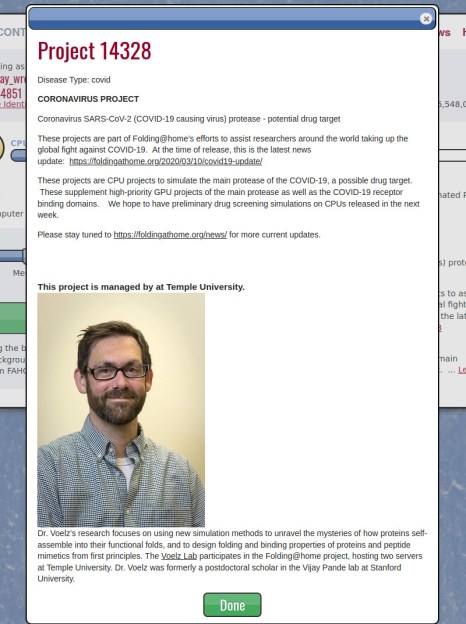On Wednesday morning we asked the Hackaday community to donate their extra computer cycles for Coronavirus research. On Thursday morning the number of people contributing to Team Hackaday had doubled, and on Friday it had doubled again. Thank you for putting those computers to work in pursuit of drug therapies for COVID-19.
I’m writing today for two reasons, we want to keep up this trend, and also answer some of the most common questions out there. Folding@Home (FAH) is an initiative that simulates proteins associated with several diseases, searching for indicators that will help medical researchers identify treatments. These are complex problems and your efforts right now are incredibly important to finding treatments faster. FAH loads the research pipeline, generating a data set that researchers can then follow in every step of the process, from identifying which chemical compounds may be effective and how to deliver them, to testing they hypothesis and moving toward human trials.
First, here’s the rundown on how easy it is to set your computer up to help with Folding@Home’s Coronavirus effort:
- Download and run the installer for Linux, Mac, or Windows. Some people reported they needed to us the alternate download links.
- Choose any name to identify your efforts on the public ranking system
- Use the Team Hackaday team number to contribute to our collective rankings: 44851
- It’s optional but I recommend getting your own passkey — it’s a hash that uniquely identifies your efforts and you can get one emailed to you on the FAH Passkey page
Okay, let’s answer some questions! First up, does this actually make a difference?
Folding@Home Has a Record of Producing Results
The Folding@Home project started back in 2000. Much has been accomplished over the course of the past 20 years and I encourage you to go and read the lengthy Examples of application in biomedical research section of the Wikipedia page which takes an in-depth look at the impacts.
The effort has identified drug therapies for Alzheimer’s and Huntington’s diseases, it’s been used in drug design for combating HIV and influenza (both are viral), and is used to study how cancer mutates. Now we have the chance to apply that to the COVID-19 virus. On an explain-it-like-I’m-five level, scientists are trying to simulate every possible combination of protein folding patterns, looking for locations that would let medicine grab hold and do some good.
It’s a huge challenge, similar to trying every combination on a padlock, but this lock takes a mind-bogglingly large number of combinations. Research scientists highlight where the most likely solutions lie, then use the mind-bogglingly huge power of the Folding@Home network and sets to work running the simulations. How powerful is the FAH network? Wikipedia lists it at 470 petaFLOPS as of early March 2020 which means 416 quadrillion floating point operations per second. That’s 416 million billion math problems solved every second!
But here’s the best part of all of this, the project is non-profit and makes the data freely available …read more
Source:: Hackaday

